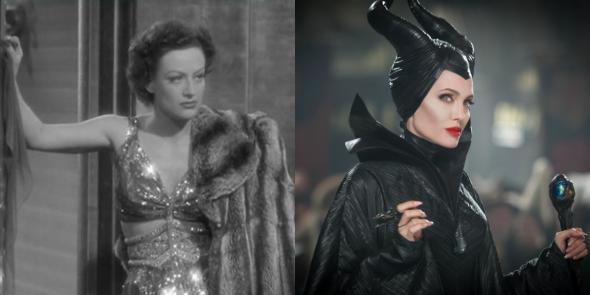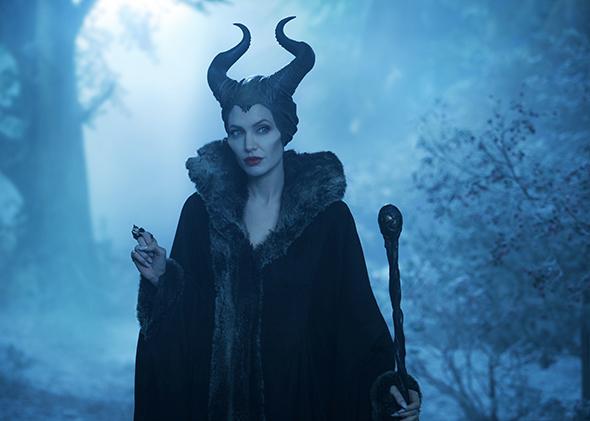From the day the first trailer hit the web, the premiere date of Maleficent, Disney’s reimagining of Sleeping Beauty from the point-of-view of the evil witch, was marked on my calendar. This was not because I make a habit of seeing “kid’s movies.” (I’ve thus far avoided Frozen, Brave, etc.) No, I made an appointment with Maleficent for entirely different demographic reasons—this was obviously a film tailor-made for the gays.
Fast-forward to a week after opening night, and obviously my obviously was too strong. While most critics have praised Angelina Jolie’s gleeful performance as the titular faerie, Maleficent’s Metacritic rating of 55 accurately represents the critical consensus on the film as a whole—it’s shallow, it’s messy, its unhorned characters are one-dimensional. But all these flaws are mostly excused by the mantra of it’s really for the children, after all. During Slate’s Culture Gabfest discussion of the film, Mike Pesca shrugged that the movie is clearly “limited in its appeal to between 5- and 12-year-old girls,” and over at Salon, Andrew O’Hehir waves away criticism by pointing out that “Disney’s target audience for this picture is not middle-aged journalists. It’s tween and early-teen girls who are ready to move half a click upward from Frozen and Brave, along with their moms.”
All this talk about the target audience is intriguing to me, given that the lobby outside my Friday night screening—which took place at a standard theater in a demographically mixed neighborhood—felt more like the line outside an establishment with Cock or Rod in its name than the one outside a Chuck E Cheese’s. I don’t think I’ve seen that many gay men at the movies since, well, the opening night of Magic Mike, and that theater had the good sense to station a go-go boy just to the left of the concession stand. Clearly, many gays sensed that Maleficent was in some way meant for them, and, as it turned out, this was true in ways even more interesting than I had anticipated. To say, then, that the movie is somehow slight because it is “only for kids” is to miss (or deny) a whole layer of queer experience.
The most obvious gay angle on Maleficent is its utter campiness. Jolie does a fabulous job of stalking around in an outfit made for a drag queen, casting biting shade and patrician disaffection wherever she goes. If this movie had been made in the 1940s, Joan Crawford would have been the actress undergoing cheekbone enhancement.

Still from The Women (1939) (left) and Maleficent (2014) (right)
But in a pleasant surprise, Jolie’s turn as a camp vamp was just the opening act for a full bill of queer themes. Properly attuned audience members should find much to identify with in Maleficent’s position as a figure both special and feared, a person who, though celebrated for her queer talents among her own people, is subject to prejudice and even physical violence once she wanders beyond the borders of her “safe space” in the faerie moors. There’s also something of a classic “falling for the straight boy” narrative in her doomed relationship with the young Stefan—he’s titillated by his brush with exoticism for a time, but his eventual (and, really, inevitable) return to the human (straight) world leaves our faerie wounded and bitter.
Indeed, Linda Woolverton’s script clearly values same-sex relationships of various sorts over straight ones; King Stefan’s wife is hardly present in the film, and Prince Philip, though adequately charming and promisingly heroic, hovers around the edges of the story (quite literally in the closing scene). As the final, spell-breaking kiss demonstrates, it is the love between women—not a sexual/romantic love, exactly, but a non-heteronormative kind to be sure—that is most powerful, most “true” love in this universe.
Personally, I was most struck by Maleficent’s exploration of queer family, the notion that the families we choose, often out of necessity, are more important than the ones we are born into. Soon-to-be-sleeping Aurora comes from a straight family, but from the moment she is cursed by Maleficent, her life takes on a queer trajectory. She is taken from the human world into a faerie land, cared for by a commune of women and later, somewhat surreptitiously, by Maleficent herself. She grows to wonder at the world and appreciate diversity in ways she never would have within the castle walls, and in the end, she expresses a desire to live with her adoptive family rather than to return “home.” Despite the requisite appearance of the fated spinning wheel for dramatic purposes, the version of events presented in Maleficent invites us to read the witch’s queer touch not as a curse, but as a blessing.
Of course, while all this stuff is present in the movie, Maleficent is, in fact, also a fun hour and a half for the whole family. Its ability to be both refreshingly queer and genuinely entertaining suggests that any diagnosis of shallowness may be the fault of the viewer—a good thing to remember next time you’re tempted to dismiss a film about a bunch of faeries.
